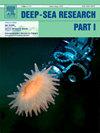海马巨鲷(Gigantidas haimaensis)鳃共生和金属耐受性的功能和微生物研究
IF 2.1
3区 地球科学
Q2 OCEANOGRAPHY
Deep-Sea Research Part I-Oceanographic Research Papers
Pub Date : 2025-06-11
DOI:10.1016/j.dsr.2025.104545
引用次数: 0
摘要
深海冷渗漏会释放出富含甲烷、硫化氢和重金属的液体,在这种极端条件下,只有少数生物(如深海贻贝)能够生存。深海贻贝通过共生微生物利用化学合成能量。本研究通过转录组测序、微生物组测序、生物化学指标测定和金属含量测定等方法,比较了海马巨鲷不同组织对环境的感知和胁迫反应,以揭示其适应机制。转录组学分析揭示了三种组织中不同的表达模式,在鳃中表达的基因更多。与地幔和内收肌相比,鳃分别有2519个和4508个差异表达基因(deg),而在地幔和内收肌之间鉴定出1453个差异表达基因。鳃中deg的上调与共生体获取、病原体识别、病原体去除、共生物质交换和氧化应激反应有关。与此同时,鳃微生物群以甲烷营养甲基藻科(>; 85%的相对丰度)为主。在分析的13种金属中,锌、铁和铜的浓度最高。与不同的金属结合途径相关的基因在不同的组织中表达。鳃也显示出更高的抗氧化能力和金属积累,强调其在应激反应中的作用。内收肌中上调的基因与肌肉收缩有关,而在套膜中上调的蛋白酶抑制剂与体液免疫有关。本研究揭示了鳃在共生体和病原菌调控以及金属胁迫响应中的重要功能,从而拓展了我们对海参在冷渗环境中的适应机制的认识。本文章由计算机程序翻译,如有差异,请以英文原文为准。

Functional and microbial insights into the gill symbiosis and metal tolerance of the cold seep mussel Gigantidas haimaensis
Deep-sea cold seeps that discharge fluids rich in methane, hydrogen sulfide, and heavy metals present extreme conditions under which only a few organisms, such as deep-sea mussels, can survive. Deep-sea mussels exploit chemosynthetic energy via symbiotic microorganisms. This study compared environmental sensing and stress responses in different tissues of Gigantidas haimaensis from the Haima cold seep through transcriptome and microbiome sequencing, biochemistry index measurements and metal content assessments to decipher its adaptive mechanisms. Transcriptomic analysis revealed distinct expression patterns among three tissues, with more genes expressed in the gill. Compared to the mantle and adductor muscle, the gill had 2519 and 4508 differentially expressed genes (DEGs), respectively, while 1453 DEGs were identified between the mantle and the adductor muscle. Up-regulated DEGs in the gill were associated with symbiont acquisition, pathogen recognition, pathogen removal, symbiotic substance exchange, and oxidative stress response. Meanwhile, the gill microbiota was dominated by methanotrophic Methylomonaceae (>85 % relative abundance). Of the 13 metals analyzed, Zn, Fe, and Cu exhibited the highest concentrations. Genes associated with distinct metal-binding pathways were expressed in different tissues. The gill also showed heightened antioxidant capacity and metal accumulation, underscoring its role in the stress response. The up-regulated genes in the adductor muscle were related to muscle contraction, while in the mantle, the up-regulated protease inhibitors were linked to humoral immunity. This study demonstrates the gill's crucial functions in symbiont and pathogen regulation as well as metal stress response, thus extending our understanding of the adaptive mechanism of G. haimaensis inhabiting cold seeps.
求助全文
通过发布文献求助,成功后即可免费获取论文全文。
去求助
来源期刊
CiteScore
4.60
自引率
4.20%
发文量
144
审稿时长
18.3 weeks
期刊介绍:
Deep-Sea Research Part I: Oceanographic Research Papers is devoted to the publication of the results of original scientific research, including theoretical work of evident oceanographic applicability; and the solution of instrumental or methodological problems with evidence of successful use. The journal is distinguished by its interdisciplinary nature and its breadth, covering the geological, physical, chemical and biological aspects of the ocean and its boundaries with the sea floor and the atmosphere. In addition to regular "Research Papers" and "Instruments and Methods" papers, briefer communications may be published as "Notes". Supplemental matter, such as extensive data tables or graphs and multimedia content, may be published as electronic appendices.

 求助内容:
求助内容: 应助结果提醒方式:
应助结果提醒方式:


